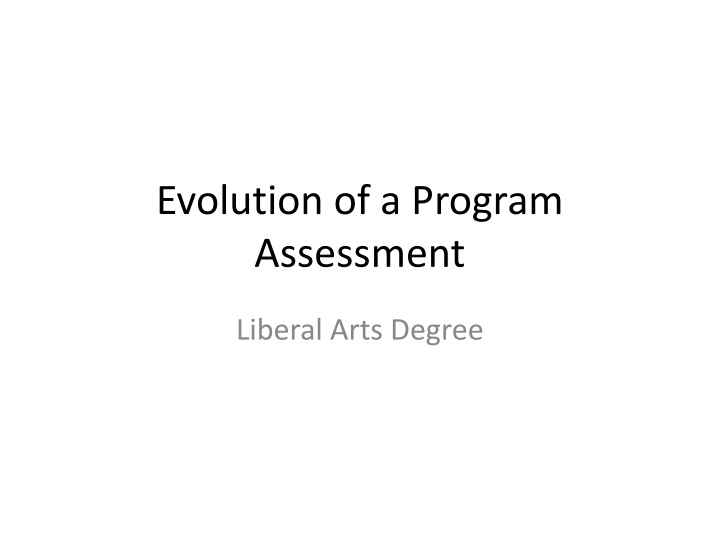
Evolution and Assessment of a Liberal Arts Degree Program
The evolution of a program assessment for a Liberal Arts degree involves tying program outcomes to student capabilities, assessing completer's abilities, and refining methods based on faculty analysis. The program at MiraCosta emphasizes critical thinking, communication, and preparation for further study. Assessments are conducted through surveys, focusing on indirect measures due to the absence of common courses. Faculty evaluations and data triangulation help refine outcomes and methods.
Download Presentation

Please find below an Image/Link to download the presentation.
The content on the website is provided AS IS for your information and personal use only. It may not be sold, licensed, or shared on other websites without obtaining consent from the author. If you encounter any issues during the download, it is possible that the publisher has removed the file from their server.
You are allowed to download the files provided on this website for personal or commercial use, subject to the condition that they are used lawfully. All files are the property of their respective owners.
The content on the website is provided AS IS for your information and personal use only. It may not be sold, licensed, or shared on other websites without obtaining consent from the author.
E N D
Presentation Transcript
Evolution of a Program Assessment Liberal Arts Degree
http://www.rccd.edu/administration/educationalservices/PublishingImages/accreditation_banner.jpghttp://www.rccd.edu/administration/educationalservices/PublishingImages/accreditation_banner.jpg Accreditation requirements Develop and Assess Program Outcomes Degree Program =General Education courses and Major courses Outcome must be tied to what students should can do upon completion of a program Develop an assessment method that captures Program completers Institutional Dialogue Faculty assess and analyze if program outcomes are being met Faculty make modifications to assessment and/or curriculum based on assessment results
Liberal Arts Degree One broad Program outcome connected to MiraCosta s ILOs and GE outcomes-All Emphasis Critical thinking Effective communication Intellectual Skills Preparation for further study http://blog.owu.edu/healthybishopblog/files/2011/04/survey.jpeg
http://www.jennifergroepl.com/rubric.gif Assessment Method Indirect measure of learning outcome Considerations No capstone course No common course in each area of emphasis Most courses for this program derive from the general education patterns Students report their perception of how well a given learning outcome has been achieved Survey method was chosen as most expedient and practical
Liberal Arts Program Assessment Faculty Evaluation and Analysis Assessments conducted: Summer, Fall 2011, Spring 2012 Faculty review and analysis; Revise program outcome; refine/add assessment method Modified survey questions; distribution method streamlined added Triangulation of CSLO data (selected GE gateway courses) http://www.focuspointeglobal.com/Portals/136660/images/encouraging-focus-group-discussion-resized-600.jpg http://www.focuspointeglobal.com/Portals/136660/images/encouraging-focus-group-discussion-resized-600.jpg http://usingdata.files.wordpress.com/2012/03/triangle1.jpg
Graduation Petitioners spring 2013 Liberal Arts AA degree: n=367 Applied Health, Nutrition & Kinesiology: 20 Arts & Humanities: 80 Business & Technology: 3 Creative & Applied Arts: 7 Math & Sciences: 100 Multicultural Studies: 2 Social & Behavioral Sciences: 155 http://educationmom.com/wp-content/uploads/2012/06/Gradua2.gif
http://t0.gstatic.com/images?q=tbn:ANd9GcSvAy_8NNXAxQVJXfXyCMDQdqjsW9GExCZQMT3Xt45Q-tcDjXhqDTkirucshttp://t0.gstatic.com/images?q=tbn:ANd9GcSvAy_8NNXAxQVJXfXyCMDQdqjsW9GExCZQMT3Xt45Q-tcDjXhqDTkirucs Survey Results Liberal Arts Program Completers Effective Communication- 90% of students responding perceived that MiraCosta courses had improved their ability to effectively communicate Productive Work Habits- 89% of students perceived that they had improved their ability to apply productive work habits 9defined as Critical Thinking-97% students perceived that they improved their Critical Thinking skills during their coursework at MCC Prepared for further Study- 95.8% of students perceived that at Miracosta they had developed skills that would assist them in achieving future education goals or requirements. Met University transfer requirements -84% of students responded yes
Linking Liberal Arts assessment to ISLO s and GELO s General Education Learning Outcomes Knowledge, skills, abilities derived from completing general education courses or a GE program GELO s overlap with Liberal Arts program outcomes (critical thinking, effective communication, productive work habits, etc) Liberal Arts degree primarily composed of GE courses Institutional Learning Outcomes Knowledge, skills, abilities and attitude students can demonstrate after completing experience as a MiraCosta student ISLO s overlap with Liberal Arts program outcomes (critical thinking, effective communication, productive work habits, etc) Program at MiraCosta with highest amount of completers
Institutional Dialogue Linking Liberal Arts Assessment to ISLO s ISLO Assessment Focus Group and Course Triangulation- Any Program completer invited to participate in assessments outside of classroom context Group Communication-Activity assessed against Communication rubric; Scoring (Out of 4.0 points) Participation: 3.5; Collaboration: 3.5; Speaking: 3.8; Listening: 3.8 Productive Work Habits-Assessment based on participation and on- time attendance-94% Critical Thinking-Individual Activity - 15% of the students met minimum achievement levels skills using Watson-Glaser CT assessment Course SLO Analysis (triangulation)-93% of students assessed in 34 gateway courses that emphasize critical thinking met minimum achievement levels
Institutional Dialogue Critical Thinking assessments http://www.ci.socorro.tx.us/wp-content/uploads/2011/05/concern.jpg Do courses that emphasize CT skills really have one or more CSLOs and assessments that test CT skills? Are we challenging our students with CT assignments? Are students practicing and implementing their CT skills in our courses? Are our assessments valid and results measurable?
Linking Liberal Arts Program Assessment to GELO s Faculty formulating Critical Thinking outcome per GE area Developing common rubric to assess that outcome Faculty to design or use existing assessments that can be graded with common critical thinking rubric Assessment to be administered to LA completers and all others in a GE course: Assessing LA program and GELO s simultaneously
Institutional Dialogue Linking Liberal Arts assessment to other Programs Programs with few Completers: Develop assessment question related to your program outcome- Add on to Liberal Arts degree This survey sent only to your Program completers; but you must assess and evaluate Collaboration required with OIE to distribute survey; department scores results
Institutional Dialogue Linking Liberal Arts assessment to other Programs Programs with no Degrees or Certificates Focus on a high ranking GE or ISLO for your courses (critical thinking, effective communication? Faculty collaboration on common definition GE or ISLO (as it pertains to your course offerings) Develop one assessment per course based on this collaboration? Higher standard of critical thinking, is it reasonable to lower minimum achievement levels? Faculty dialogue: Evaluate, discuss, modify curriculum as needed; Enter data into Program Review Discuss unofficial programs (Tidepools) that are effectively meeting ISLO/GELO s- how can they be assessed?(Exit Interviews, inter-departmental faculty reviewing work)





















